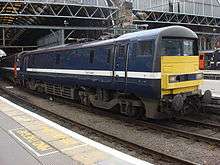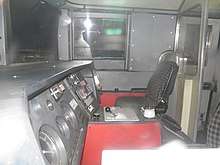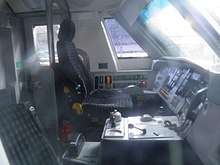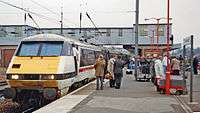British Rail Class 91
The British Rail Class 91 is a class of high-speed, 4,830 kW (6,480 hp) electric locomotive ordered as a component of the East Coast Main Line modernisation and electrification programme of the late 1980s. The Class 91s were given the auxiliary name of InterCity 225 to indicate their envisaged top speed of 225 km/h (140 mph); they were also referred to as Electras by British Rail during their development and throughout the electrification of the East Coast Main Line. The other end of the InterCity 225 train set is formed of a Mark 4 Driving Van Trailer, built with a similar body shell to the Class 91 locomotives. The locomotive body shells are of all-steel construction. Unusually, the motors are body mounted and drive bogie-mounted gearboxes via cardan shafts. This reduces the unsprung mass and hence track wear at high speeds. The locomotive also features an underslung transformer, so that the body is relatively empty compared to contemporary electric locomotives. Much of the engineering specification for the locomotive was derived from the research and operational experience of the APT-P.[1][3][4]
| British Rail Class 91 Intercity 225 | |||||||||||||||||||||||||||||
|---|---|---|---|---|---|---|---|---|---|---|---|---|---|---|---|---|---|---|---|---|---|---|---|---|---|---|---|---|---|
London North Eastern Railway 91125 at London King's Cross in July 2018 | |||||||||||||||||||||||||||||
| |||||||||||||||||||||||||||||
| |||||||||||||||||||||||||||||
| |||||||||||||||||||||||||||||
| |||||||||||||||||||||||||||||
History
In 1985, ASEA, Brush and GEC Transportation Projects tendered for the design and construction of the Class 91s.[5] GEC subsequently won the bid and the fleet was built by sub-contractors British Rail Engineering Limited's Crewe Works between 1988 and 1991.
The Class 91s began passenger service on 3 March 1989, when 91001 worked 1P26 17.36 London Kings Cross to Peterborough train. This train was formed of InterCity 125 Mark 3 coaches and a Class 43 power car, which had been converted for use as a DVT as the Mark 4 coaches were not then ready. The Class 91s then began service on King's Cross to Leeds trains on 11 March 1989, when 91008 with a rake of Intercity 125 Mark 3 coaches and power car 43068 worked the 1D32 06:50 Kings Cross to Leeds service. The set then worked 1A12, the 10:00 Leeds to London Kings Cross service.
In the early 1990s, after the cancellation of InterCity 250, British Rail examined the option of ordering a further set of ten Class 91s to operate on the West Coast Main Line with UK Treasury support, however the business case for these failed to prove sufficiently worthwhile [6] and led to the electric Networker Classes 365, 465 and 466 EMU Networker stock's procurement being taken forward.

The asymmetric body style is streamlined at one end to allow high-speed operation, with the fixed sets of Mark 4 coaches in normal push-pull passenger operation. An additional requirement of the design was that they could operate as normal locomotives. This led to a second cab being incorporated into the unstreamlined 'blunt end'. Operating with the blunt end first limits the maximum speed of the locomotive to 110 mph (180 km/h), due to the aerodynamics of the pantograph's knuckle creating excessive uplift force on the OLE.
Since privatisation, the fleet has been owned by Eversholt Rail Group who lease it to the operators. Between 2000 and 2003, the whole fleet underwent a refit (Project Delta) to improve reliability. The Class 91 units were refurbished at Bombardier Transportation at its Doncaster Works. This has resulted in the renumbering of the fleet from 910xx to 911xx. During this time, GNER hired in Class 90 locomotives to provide cover.[7]
Speed record
A Class 91, 91010 (now 91110), holds the British locomotive speed record at 161.7 mph (260.2 km/h), set on 17 September 1989,[8] just south of Little Bytham on a test run down Stoke Bank with the DVT leading. Although Class 370s, Class 373s and Class 374s have run faster, all are EMUs which means that the Electra is officially the fastest locomotive in Britain. Another loco (91031, now 91131), hauling five Mk4s and a DVT on a test run, ran between London King's Cross and Edinburgh Waverley in 3 hours, 29 minutes and 30 seconds on 26 September 1991. This is still the current record. The set covered the route in an average speed of 112.5 mph (181.1 km/h) and reached the full 140 mph (225 km/h) several times during the run.
Fleet


When British Rail was privatised, the InterCity livery was progressively removed and new operator GNER applied their corporate livery of blue and red. When GNER lost their franchise in 2007, the red stripe was replaced by a white stripe containing the words National Express and East Coast. National Express East Coast originally planned to repaint all of their InterCity 225 sets in the white and silver NXEC corporate livery within two years. However, the collapse of NXEC in 2009 and its replacement with East Coast saw this repainting programme cancelled. As a result, 91111 was the only locomotive to receive the full National Express livery.[9]
In June 2010, a new silver livery with a purple stripe was unveiled by East Coast.[10] By February 2011, locomotives 91101,[11] 91106, 91107 and 91109 carried this livery. Locomotive 91101 was soon given maroon vinyls, with Flying Scotsman branding. Locomotive 91107 was given promotional "Skyfall" vinyls for a time during 2012/3. The locomotive later returned to conventional Virgin Trains East Coast livery. Locomotive 91110 carries 'BBMF' Battle Of Britain Memorial Flight livery. By 2013, all locomotives carried the standard East Coast livery of silver/grey with a purple stripe. 91118 was the last locomotive to carry GNER/NXEC livery. All Mark 4 coaches and DVTs have since been repainted. On 14 October 2014 at Newcastle station, locomotive 91111 was unveiled in a commemorative World War One livery and named 'For The Fallen'.[12]
The Class 91 fleet has carried nameplates applied in various batches and themes. Immediately after repainting into GNER colours in the late 1990s, all locomotives were briefly nameless. Having initially been applied to only a few locomotives in the early 1990s using cast-iron plates, eventually the whole fleet was named, many multiple times, until all were removed in 2008. In 2011, in response to customer requests, East Coast resumed the practice. It began by naming No. 91109 as Sir Bobby Robson with cast-iron plates, unveiled in a ceremony at Newcastle station on 29 March by his widow Elsie and Alan Shearer.[13][14]
Locomotive 91023 was involved in both the Hatfield rail crash and the Great Heck rail crash. After refurbishment in 2001, it was renumbered 91132 (rather than 91123).
In November 2012, unit 91114 had a second pantograph added as a pilot project operated jointly by Eversholt Rail Group, East Coast, ESG, Wabtec Rail and Brecknell Willis. The new design uses the same mounting positions as a conventional pantograph but pairs two pantograph arms in an opposing configuration. If there is an ADD (Automatic Dropping Device) activation or the pantograph becomes detached, the train can keep going, so the system provides redundancy in the event of a pantograph/OLE failure.[15][16]This has since been removed, but the extended lower roof is still visible.
| Class | Operator | No. of locos | Locomotive Numbers | Status |
|---|---|---|---|---|
| Class 91/1 | London North Eastern Railway | 12 | 91101, 91105-91107, 91109- 91111,91114,91119,91124,91127,91130 | Originally numbered 91001-91031. |
| Europhoenix | 2 | 91117, 91120 | ||
| Off Lease/Storage | 17 | 91102-104, 91108, 91112, 91113, 91115-116, 91118, 91121-91122,91125-91126,91128-91129,91131-91132 |
| Year | Quantity in service at start of year | Quantity withdrawn | Numbers |
|---|---|---|---|
| 2019 | 31 | 6 | 91103/104/108/117/120/122 |
| 2020 | 25 | 11 | 112/113/115/118/121/125/126/128/129/131/132 |
Operators
| Operator | Years | Livery | Image |
|---|---|---|---|
| InterCity | 1988—1996 | Intercity Swallow |  |
| Great North Eastern Railway | 1996—2007 | Navy blue with red detailing | .jpg) |
| National Express East Coast | 2007—2009 | National Express corporate grey | .jpg) |
| East Coast | 2009—2015 | East Coast silver with purple stripe | .jpg) |
| Virgin Trains East Coast | 2015—2018 | Virgin Trains corporate red and white | |
| London North Eastern Railway | 2018— | LNER red and white (VTEC red/white with LNER branding) | |
| Europhoenix | 2019— | Europhoenix grey, silver and red (with a phoenix motif branding) |
Current operations
The fleet, which was previously operated by InterCity and then GNER, National Express East Coast, East Coast and Virgin Trains East Coast, is currently run by London North Eastern Railway.
In July 2019, 91108 was the first of the class to be withdrawn.[17] Following the withdrawal of the InterCity 125 fleet in December 2019, it was previously thought that the InterCity 225 fleet would be fully withdrawn by June 2020.[18] However, LNER announced on 29 January 2020 that they would be retaining a limited number of the InterCity 225 fleet to deliver all of the benefits of their December 2021 timetable.[19] LNER later confirmed that they would be keeping 10 sets in service.[20]
Future operations
Europhoenix purchased 91117 and 91120 in September 2019. They were repainted at Bounds Green TMD before moving to UK Rail Leasing's Leicester depot. They are to be re-geared for freight operation in Europe.[21]
Rail Operations Group have taken a pair of Class 91s for use in testing of the newly electrified Midland Main Line prior to the introduction of regular electric services between Bedford and Corby.[22] The company has also expressed interest in using the Class 91s on high speed logistics trains.[23]
Grand Union is proposing to operate InterCity 225s on London Paddington to Cardiff Central and London Euston to Stirling services.[24][25]
Preservation
Upon retirement, 91110 will be preserved as part of the National Collection, having been nominated by the Railway Heritage Committee.[26]
References
- Jean-Marc Allenbach, "BoBo BR 91 (Spec Sheet)" (PDF), documents.epfl.ch (in French)
- https://www.railmagazine.com/news/network/europhoenix-earmarks-91s-for-european-freight-use
- "The Design and Development of the Class 91 Locomotive", P J Donnison and G R West, Main Line Railway Electrification Conference 1989 - Proceedings of the Institute of Electrical Engineers, 1989.
- "The design, manufacture and assembly of the British Rail Class 91, 25 kV 225km/h locomotive", M L Broom and G W Smart, Proceedings of the Institute of Mechanical Engineers Vol. 205, 1990.
- Ford, Roger (April 1988). "Managing Electra". Modern Railways. ISSN 0026-8356.
- Vincent, Mike (2013). InterCity Story 1964-2012. Oxford Publishing Company. ISBN 978-0860936527.
- Pritchard, Fox & Hall (2007). British Railways Locomotives & Coaching Stock 2007. Sheffield, UK: Platform 5 Publishing Ltd. ISBN 978-1-902336-55-8.
- "Class 91 hits 162 mph". Rail. No. 106. EMAP National Publications. 5–18 October 1989. p. 5. ISSN 0953-4563. OCLC 49953699.
- 91111 East Coast Newcastle Central. Flickr. Retrieved 5 November 2010
- Cover, Ron (9 August 2010). Tuplin, Richard (ed.). "East Coast goes silver and purple!" (PDF). Railway Herald (223): 3. ISSN 1751-8091. Archived from the original (PDF) on 15 July 2011. Retrieved 12 August 2010.
- "91101 at Leeds". 5 October 2010. Archived from the original on 27 September 2011.
- "East Coast unveils tribute "For the Fallen"" (Press release). East Coast. 14 October 2014. Archived from the original on 19 December 2014. Retrieved 5 January 2015.
- "Sir Bobby Robson name given to train". BBC News. 29 March 2011. Retrieved 29 March 2011.
- "East Coast Names Train Sir Bobby Robson" (Press release). East Coast. 29 March 2011. Archived from the original on 29 March 2011. Retrieved 29 March 2011.
- "Second pantograph fitted to '91' in bid to cut failures". Rail. Peterborough. 28 November 2012. p. 6.
- "Duplex pantograph prototype unveiled", www.railwaystrategies.co.uk, 1 February 2013, retrieved 12 November 2013
- First Class 91 withdrawn from traffic by LNER Rail issue 884 31 July 2019 page 28
- "FROM THE ARCHIVES: Traction transition: HST to Azuma". www.railmagazine.com. Retrieved 17 January 2020.
- Railway, London North Eastern (29 January 2020). "If you're a fan of our IC225 trains, you can continue to enjoy them for a bit longer. We are retaining a number of them in order to deliver all of the benefits of our Dec 2021 timetable plans. Here is our favourite, For the Fallen, at York Station.pic.twitter.com/ry89sQ45JE". @LNER. Retrieved 30 January 2020.
- Railway, London North Eastern (5 February 2020). "18 currently and we are keeping 10 till the end of 2021. ^SM". @LNER. Retrieved 5 February 2020.
- Europhoenix earmarks ‘91s’ for European freight use Rail 10 October 2019
- Clinnick, Richard (5 February 2020). "ROG to use Class 91s for Midland Main Line electrification testing". Rail Magazine. Bauer Media. Retrieved 27 July 2020.
- Clinnick, Richard (24 April 2019). "May start for withdrawal of LNER's redundant trains". Rail Magazine. No. 877. Peterborough: Bauer Media. p. 32. ISSN 0953-4563.
- Cardiff - London open access plan Railway Gazette International 19 June 2019
- - Notification to the Office of Rail and Road of a Proposed service that may be subject to the economic equilibrium Office of Rail and Road
- Class 60 to be saved for preservation Rail issue 678 7 September 2011 page 33
Literature
- P.J. Donnison; G.R. West (25–28 September 1989), Institution of Electrical Engineers (ed.), "The design and development of the class 91 locomotive", IEE Conference Publication (312): 294–298, ISBN 978-0-85296-384-5
- P.C. Bennett (25–28 September 1989), Institution of Electrical Engineers (ed.), "Aspects of the design, construction and testing of BRB's Class 90 and 91 locomotive transformers", IEE Conference Publication (312): 279–283, ISBN 978-0-85296-384-5
- R. Dettmer (12 May 1998), "The Class 91 locomotive. Learning from the APT", IEE Review, 34 (5): 188–189, doi:10.1049/ir:19880072, ISSN 0953-5683
- Broom, M. L.; Smart, G. W. (1990). "The design, manufacture and assembly of the wheelset for the British Rail Class 91, 25 kV, 225 km/h locomotive". Proceedings of the Institution of Mechanical Engineers, Part F: Journal of Rail and Rapid Transit. 204 (26): 141. doi:10.1243/PIME_PROC_1990_204_200_02.
External links
| Wikimedia Commons has media related to British Rail Class 91. |
- Dave Coxon, "IC225 and Class 91 commissioning", www.traintesting.com, archived from the original on 15 November 2005
- "Running to Time", www.youtube, Channel 4 / Equinox (series), 1998